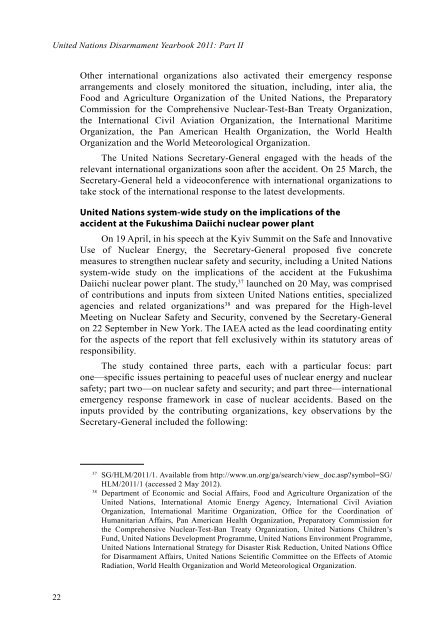DYB2011-Part-II-web
DYB2011-Part-II-web
DYB2011-Part-II-web
Create successful ePaper yourself
Turn your PDF publications into a flip-book with our unique Google optimized e-Paper software.
United Nations Disarmament Yearbook 2011: <strong>Part</strong> <strong>II</strong><br />
22<br />
Other international organizations also activated their emergency response<br />
arrangements and closely monitored the situation, including, inter alia, the<br />
Food and Agriculture Organization of the United Nations, the Preparatory<br />
Commission for the Comprehensive Nuclear-Test-Ban Treaty Organization,<br />
the International Civil Aviation Organization, the International Maritime<br />
Organization, the Pan American Health Organization, the World Health<br />
Organization and the World Meteorological Organization.<br />
The United Nations Secretary-General engaged with the heads of the<br />
relevant international organizations soon after the accident. On 25 March, the<br />
Secretary-General held a videoconference with international organizations to<br />
take stock of the international response to the latest developments.<br />
United Nations system-wide study on the implications of the<br />
accident at the Fukushima Daiichi nuclear power plant<br />
On 19 April, in his speech at the Kyiv Summit on the Safe and Innovative<br />
Use of Nuclear Energy, the Secretary-General proposed five concrete<br />
measures to strengthen nuclear safety and security, including a United Nations<br />
system-wide study on the implications of the accident at the Fukushima<br />
Daiichi nuclear power plant. The study, 37 launched on 20 May, was comprised<br />
of contributions and inputs from sixteen United Nations entities, specialized<br />
agencies and related organizations38 and was prepared for the High-level<br />
Meeting on Nuclear Safety and Security, convened by the Secretary-General<br />
on 22 September in New York. The IAEA acted as the lead coordinating entity<br />
for the aspects of the report that fell exclusively within its statutory areas of<br />
responsibility.<br />
The study contained three parts, each with a particular focus: part<br />
one—specific issues pertaining to peaceful uses of nuclear energy and nuclear<br />
safety; part two—on nuclear safety and security; and part three—international<br />
emergency response framework in case of nuclear accidents. Based on the<br />
inputs provided by the contributing organizations, key observations by the<br />
Secretary-General included the following:<br />
37 SG/HLM/2011/1. Available from http://www.un.org/ga/search/view_doc.asp?symbol=SG/<br />
HLM/2011/1 (accessed 2 May 2012).<br />
38 Department of Economic and Social Affairs, Food and Agriculture Organization of the<br />
United Nations, International Atomic Energy Agency, International Civil Aviation<br />
Organization, International Maritime Organization, Office for the Coordination of<br />
Humanitarian Affairs, Pan American Health Organization, Preparatory Commission for<br />
the Comprehensive Nuclear-Test-Ban Treaty Organization, United Nations Children’s<br />
Fund, United Nations Development Programme, United Nations Environment Programme,<br />
United Nations International Strategy for Disaster Risk Reduction, United Nations Office<br />
for Disarmament Affairs, United Nations Scientific Committee on the Effects of Atomic<br />
Radiation, World Health Organization and World Meteorological Organization.


